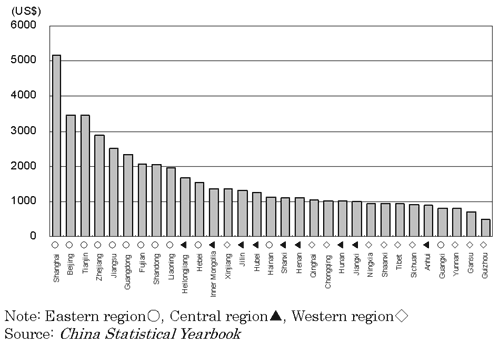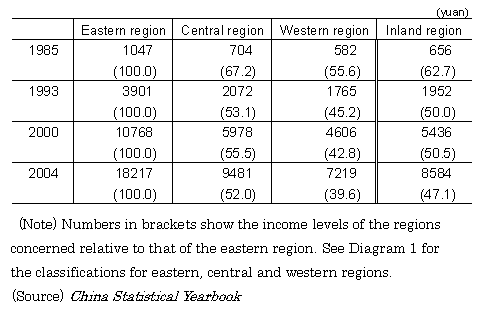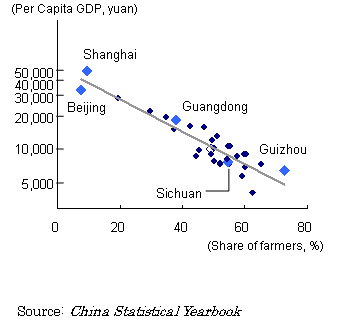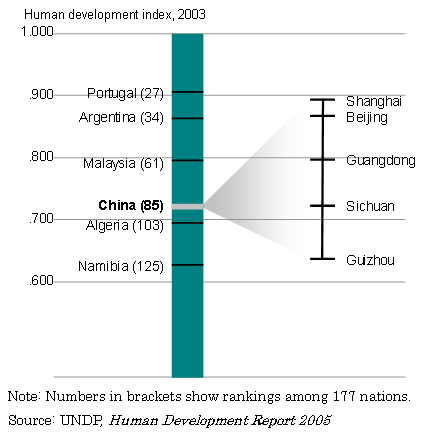Regional disparities in China are striking, even by global standards. When the 31 provinces, municipalities and autonomous districts (the equivalent of prefectures in Japan) are lined up in order of their per capita gross domestic product figures for 2004, there is a more than tenfold gap between Shanghai, which tops the list with $5,165, and Guizhou, which comes in last with just $492 (diagram 1). Correcting regional disparities is an important issue for the government of President Hu Jintao and Premier Wen Jiabao, which is striving to build an "all-round well-off society."
In addition to such objective reasons as natural and geographical factors, historical and cultural factors, and differences in economic fundamentals and market potential, the widening regional disparities also reflect choices in economic systems and policies and development strategies. The coastal regions, which were designated as the areas to be opened up to the outside in the 1980s and have reaped the benefits of the influx of foreign investment, have especially achieved higher growth and income levels. In fact, according to 2004 figures, when the per capita GDP of the eastern region (population 541 million) is set at 100, the corresponding figures for the central region (population 454 million) and the western region (population 299 million) are much lower -- 52.0 and 39.6, respectively (table 1). Furthermore, there is a conspicuous trend in which the higher the share of farmers in a region's population, the lower its per capita GDP, and the issue of regional disparities and that of the gap between rural and urban areas are two sides of the same coin (diagram 2).
Professor Hu Angang, director of the Center for China Study at Tsinghua University's School of Public Policy and Management, has described these excessively large regional disparities in China as "one China, four worlds". In other words, China is a country where the First World -- cities such as Beijing, Shanghai and Shenzhen where income levels (in terms of purchasing power parity) are nearing those of developed countries (2.2% percent of the total population), the Second World -- provinces such as Guangdong, Jiangsu and Zhejiang that exceed the world's average income (22% of the population), the Third World -- central Chinese provinces that remain at developing nation levels (26% of the population) and the Fourth World, represented by inland provinces such as Guizhou and Tibet (roughly half of the population) co-exist.
Not only is there a huge gap in residents' income among these "four worlds," there are also large disparities in areas such as education and health. When comparing China with other countries based on the Human Development Index, which combines such factors as per capita income, literacy rate and average life expectancy, China ranks 85th -- around the middle -- among the 177 nations surveyed. Shanghai and Beijing, which are the most economically advanced areas in China, have achieved the levels of Portugal (27th) and Argentina (34th), respectively, while the least developed, Guizhou Province, remains on a level equivalent to that of Namibia (125th) (United Nations Development Programme, Human Development Report 2005). Guangdong Province, which is positioned in the middle of these areas, is ranked on the same level as Malaysia (61st) (diagram 3).
This suggests that the fruits of China's remarkable economic development have not been evenly distributed among all the people. To redress this problem, the "Communist Party of China Central Committee's Proposal on the Formulation of the 11th Five-Year Plan" that was adopted by the Fifth Plenum of the 16th CPC Central Committee in October 2005 says that in addition to "developing the western region, revitalizing northeastern old industrial bases, promoting the rise of the central region and encouraging the eastern region to take the lead in development," the government should promote regional cooperation whereby "the eastern, central and western regions act together, take advantage of each other's strengths and enjoy common development." This is to be achieved through the establishment of a unified market in which the free flow of goods, people and capital is guaranteed (a domestic free-trade agreement), the creation of a system of division of labor in line with comparative advantages (a domestic flying-geese pattern) and fiscal transfers among regions through the central government budget (domestic official development assistance).
| Diagram 1: China's Per capita GDP by Province (2004) |
 |
| click to enlarge |
| Table 1: The increasing income gap between the eastern and inland regionstion |
 |
| Diagram 2: | Per capita GDP of each province is in inverse proportion to the share of farmers in the population |
 | |
| Diagram 3: | China's regional disparities as seen from the Human Development Index |
 | |


